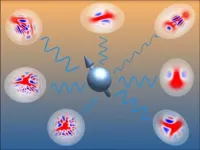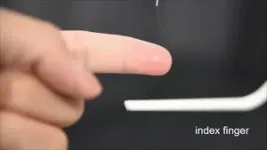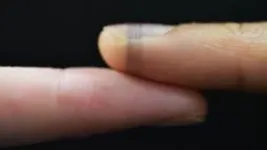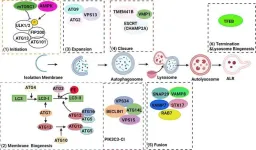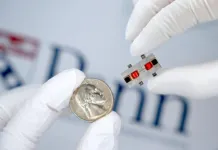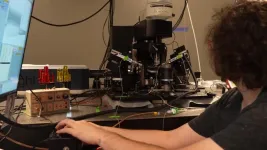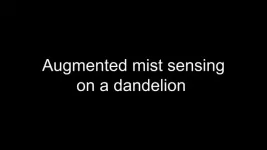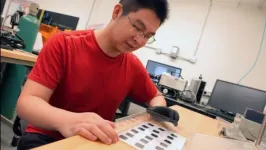(Press-News.org) Many of today’s quantum devices rely on collections of qubits, also called spins. These quantum bits have only two energy levels, the ‘0’ and the ‘1’. However, spins in real devices also interact with light and vibrations known as bosons, greatly complicating calculations. In a new publication in Physical Review Letters, researchers in Amsterdam demonstrate a way to describe spin-boson systems and use this to efficiently configure quantum devices in a desired state.
Quantum devices use the quirky behaviour of quantum particles to perform tasks that go beyond what ‘classical’ machines can do, including quantum computing, simulation, sensing, communication and metrology. These devices can take many forms, such as a collection of superconducting circuits, or a lattice of atoms or ions held in place by lasers or electric fields.
Regardless of their physical realisation, quantum devices are typically described in simplified terms as a collection of interacting two-level quantum bits or spins. However, these spins also interact with other things in their surroundings, such as light in superconducting circuits or oscillations in the lattice of atoms or ions. Particles of light (photons) and vibrational modes of a lattice (phonons) are examples of bosons.
Unlike spins, which have only two possible energy levels (‘0’ or ‘1’), the number of levels for each boson is infinite. Consequently, there are very few computational tools for describing spins coupled to bosons. In their new work, physicists Liam Bond, Arghavan Safavi-Naini and Jiří Minář of the University of Amsterdam, QuSoft and Centrum Wiskunde & Informatica work around this limitation by describing systems composed of spins and bosons using so-called non-Gaussian states. Each non-Gaussian state is a combination (a superposition) of much simpler Gaussian states.
Each blue-red pattern in the image above represents a possible quantum state of the spin-boson system. “A Gaussian state would look like a plain red circle, without any interesting blue-red patterns,” explains PhD candidate Liam Bond. An example of a Gaussian state is laser light, in which all light-waves are perfectly in sync. “If we take many of these Gaussian states and start overlapping them (so that they’re in a superposition), these beautifully intricate patterns emerge. We were particularly excited because these non-Gaussian states allow us to retain a lot of the powerful mathematical machinery that exists for Gaussian states, whilst enabling us to describe a far more diverse set of quantum states.”
Bond continues: “There are so many possible patterns that classical computers often struggle to compute and process them. Instead, in this publication we use a method that identifies the most important of these patterns and ignores the others. This lets us study these quantum systems, and design new ways of preparing interesting quantum states.”
The new approach can be exploited to efficiently prepare quantum states in a way that outperforms other traditionally used protocols. “Fast quantum state preparation might be useful for a wide range of applications, such as quantum simulation or even quantum error correction,” notes Bond. The researchers also demonstrate that they can use non-Gaussian states to prepare ‘critical’ quantum states which correspond to a system undergoing a phase transition. In addition to fundamental interest, such states can greatly enhance the sensitivity of quantum sensors.
While these results are very encouraging, they are only a first step towards more ambitious goals. So far, the method has been demonstrated for a single spin. A natural, but challenging extension is to include many spins and many bosonic modes at the same time. A parallel direction is to account for the effects of the environment disturbing the spin-boson systems. Both of these approaches are under active development.
END
More than spins: Exploring uncharted territory in quantum devices
2024-05-24
ELSE PRESS RELEASES FROM THIS DATE:
SG ramps up cancer fight with S$50 million in national grant funding for precision oncology
2024-05-24
Singapore, 24 May 2024 – Two multi-institution and multidisciplinary Singapore teams of clinician-scientists and researchers have been awarded grants of S$25 million each, by the Singapore Ministry of Health through the NMRC Office, MOH Holdings Pte Ltd, under the NMRC Open Fund-Large Collaborative Grant (OF-LCG) programme. The S$50 million support for cancer research establishes the SYMPHONY 2.0 and Colo-SCRIPT research programmes to drive precision oncology research in Singapore aimed at improving the understanding, diagnosis and treatment of lymphoma and colorectal cancer.
Led by the ...
Autophagy in pancreatitis
2024-05-24
Researchers are exploring a new potential avenue for pancreatitis treatment: autophagy, a cellular recycling process. Autophagy helps maintain healthy pancreatic acinar cells by removing damaged organelles like mitochondria and the endoplasmic reticulum (ER).
A new review published in eGastroenterology highlights the link between defective autophagy and pancreatitis. Impaired autophagy contributes to pancreatitis by allowing damaged organelles to accumulate within acinar cells. This accumulation disrupts cellular function and can ultimately lead to cell death.
"Autophagy plays a vital role in keeping pancreatic acinar cells healthy," ...
To 6G and beyond: Penn engineers unlock the next generation of wireless communications
2024-05-24
In the early 2010s, LightSquared, a multibillion-dollar startup promising to revolutionize cellular communications, declared bankruptcy. The company couldn’t figure out how to prevent its signals from interfering with those of GPS systems.
Now, Penn Engineers have developed a new tool that could prevent such problems from ever happening again: an adjustable filter that can successfully prevent interference, even in higher-frequency bands of the electromagnetic spectrum.
“I ...
USF researcher using VR to map the brain, understand and treat disorders such as autism
2024-05-24
TAMPA, Fla. (May 24, 2024) – Through high-tech imaging and virtual reality, a University of South Florida medical engineering professor is creating a detailed map of the brain that can be used to better understand developmental disorders, such as autism, and provide earlier, more effective treatments for brain injuries and diseases.
Funded by a $3.3 million grant from the National Institutes of Health, George Spirou is expanding on his four decades of brain research to focus on the part of the brain that ...
Semaglutide significantly reduces risk of major kidney disease events, cardiovascular outcomes and mortality in patients with type 2 diabetes and chronic kidney disease, groundbreaking study reveals
2024-05-24
Semaglutide significantly reduces risk of major kidney disease events, cardiovascular outcomes and mortality in patients with type 2 diabetes and chronic kidney disease, groundbreaking study reveals
A pioneering study has demonstrated that semaglutide significantly reduces the risk of major kidney disease events, cardiovascular outcomes, and all-cause mortality in patients with type 2 diabetes and chronic kidney disease.1 The landmark trial, presented today at the 61st ERA Congress, will pave the way for new treatment strategies and ...
Unveiling a novel AAK1 inhibitor: How chemical proteomics unlocked therapeutic potential
2024-05-24
Enhancing drug development for life-threatening diseases like cancer hinges on a deep understanding of protein kinases, making it a focal point for researchers. These enzymes, encoded by more than 500 human genes, serve as critical players in cellular signaling pathways. However, if these signals are dysregulated, they can disrupt the normal cellular mechanisms, leading to diseases such as cancer. Protein kinase inhibitors have therefore provided a promising avenue in therapeutic intervention to disrupt the aberrant signaling ...
Novel organic photoredox catalysts with enhanced stability and recyclability
2024-05-24
In recent years, global environmental concerns have prompted a shift toward eco-friendly manufacturing in the field of organic synthetic chemistry. In this regard, research into photoredox catalytic reactions, which use light to initiate redox or reduction-oxidation reactions via a photoredox catalyst, has gained significant attention. This approach reduces the reliance on harsh and toxic reagents and uses visible light, a clean energy source.
A key research area has been the development of recycling methods for photocatalysts, which offer both economic and environmental benefits. Photocatalysts use light to accelerate a chemical reaction without getting consumed in the process, and photoredox ...
Imperceptible sensors made from ‘electronic spider silk’ can be printed directly on human skin
2024-05-24
Researchers have developed a method to make adaptive and eco-friendly sensors that can be directly and imperceptibly printed onto a wide range of biological surfaces, whether that’s a finger or a flower petal.
The method, developed by researchers from the University of Cambridge, takes its inspiration from spider silk, which can conform and stick to a range of surfaces. These ‘spider silks’ also incorporate bioelectronics, so that different sensing capabilities can be added to the ‘web’.
The fibres, at least 50 times smaller than a ...
Virginia Tech researcher’s breakthrough discovery uses engineered surfaces to shed heat
2024-05-24
Splash a few drops of water on a hot pan and if the pan is hot enough, the water will sizzle and the droplets of water seem to roll and float, hovering above the surface.
The temperature at which this phenomenon, called the Leidenfrost effect, occurs is predictable, usually happening above 230 degrees Celsius. The team of Jiangtao Cheng, associate professor in the Virginia Tech Department of Mechanical Engineering, has discovered a method to create the aquatic levitation at a much lower temperature, and the results have been published in Nature ...
How a tiny device could lead to big physics discoveries and better lasers
2024-05-24
Researchers at Rensselaer Polytechnic Institute have fabricated a device no wider than a human hair that will help physicists investigate the fundamental nature of matter and light. Their findings, published in the journal Nature Nanotechnology, could also support the development of more efficient lasers, which are used in fields ranging from medicine to manufacturing.
The device is made of a special kind of material called a photonic topological insulator. A photonic topological insulator can guide photons, the wave-like particles that make up light, ...
